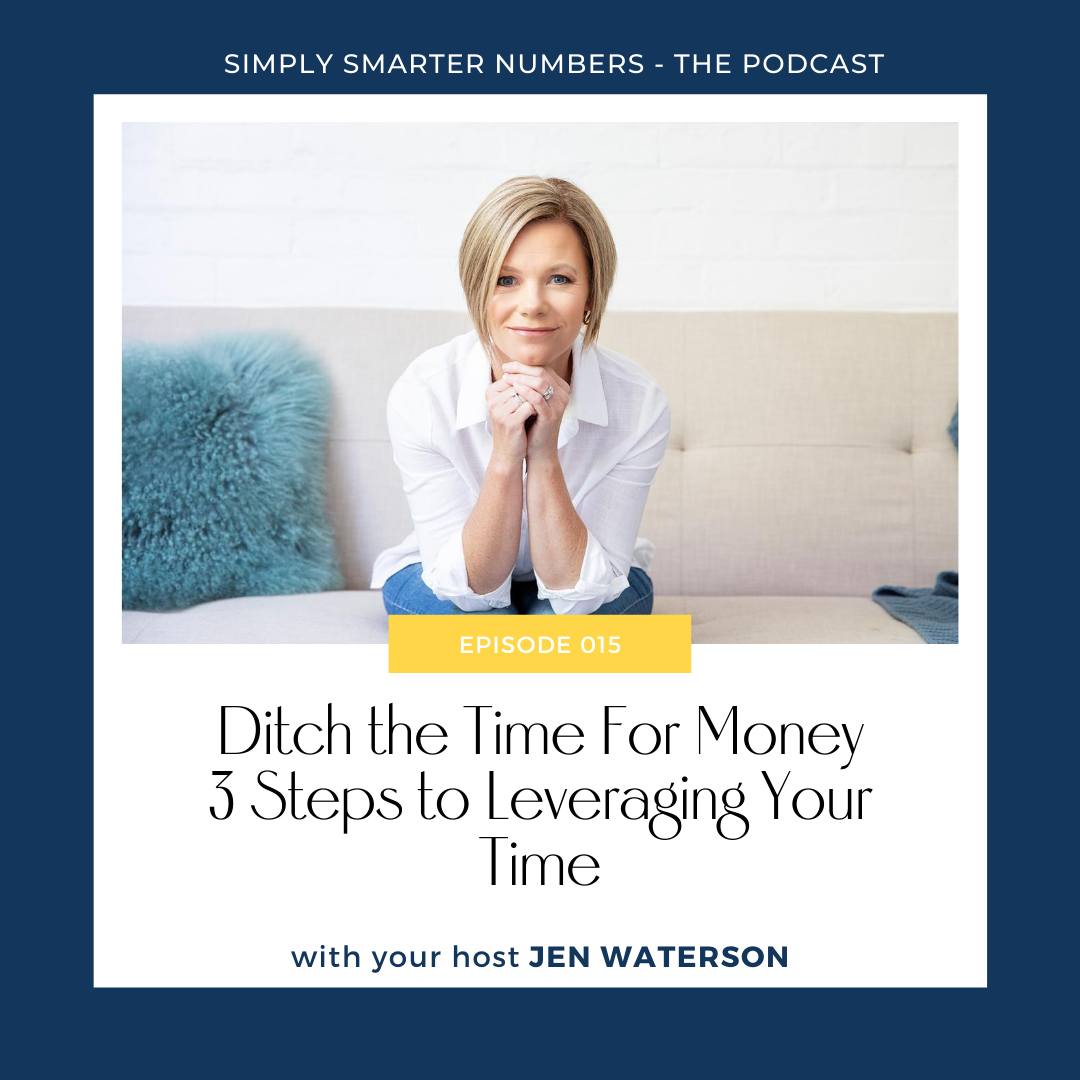
Here’s what we’ll cover
This week I’m talking about how to reduce your reliance on time for money by building some leverage into your business. Time for money is commonplace among service businesses. The problems with selling time for money is of course that the heavy reliance on the business owner to make money creates unnecessary stress and pressure. Time for money also puts a cap on our growth, whether we like it or not.
I’m talking about introducing leverage into your business and the part that it plays in building the most elegant version of your business. An ‘elegant version’ as opposed to a ‘busy version’.
In particular, I’m talking through my SOS Leverage Ladder. This is a 3 step process to get you set to ditch the time for money business model. We talk through Streamlining your systems and why this is the absolute first and only place to start. Next we talk Outsourcing and looking at whether outsourcing will help or hinder your leveraged growth. Finally, it’s all about Structures and what your options are to structure your services to create leverage in your business.
I then take a deep dive into my personal favourite structure to build leverage – the Hybrid 1 to many program.
Links and Resources
- Checkout the Simply Smarter Numbers website HERE
- Checkout the Podcast HERE
- Checkout the Instagram page HERE
- Register for my Masterclass HERE
Here’s the shownotes
I’ve been working with businesses for around 20 years. So, I’ve seen and done things ‘the old-fashioned way’ and I’ve seen and done things ‘the modern way’. The old fashioned way to grow your business was to get up early, work late and catch-up on weekends, the ‘I’ll do it my way’ kinda way also known as the ‘busy way’.
The modern way to grow your business utilises technology, systems, software, professionals, experts, collaborations, affiliations, the ‘I’ll put my hand up and ask for help’ kinda way aka the ‘elegant way’.
Today I’m talking about introducing leverage into your business and the part that it plays in building the most elegant version of your business. An ‘elegant version’ as opposed to a ‘busy version’.
To be more specific, we’re talking about leveraging your time as a business owner. It’s for the business owner who wants to get more back for the effort they are putting in. It’s for you if you want to find more profit and find more time by leveraging your time in your business.
Let me explain it again in another way. You have 8 busy hours in your working day. When you leverage your time in your business you are finding ways to get say 12 hours worth of profitable work done in just 8 hours. Then maybe upping it to 15 hours worth of profitable work done in just 8 hours. Introducing leverage into your business reduces your reliance on ‘time for money’ and removes the ceiling capping your growth.
I’m going to talk you through something I call the SOS Leverage Ladder then I’m going to dial in on one of the methods you can use to create leverage in your business.
There’s no switch to flick on and create leverage. If you want to successfully build a leveraged business there’s a process to follow that will give you the best, most elegant result.
The SOS leverage ladder is a 3 step process. Streamline. Outsource. Structure.
The first step is Streamlining. Identifying and streamlining the systems you already have in your business is the first and only place to start.
Why? Because as you leverage your time in your business, you’ll multiply your sales activity. Multiplying your sales activity fivefold, will multiply your need to use your existing systems fivefold and naturally, magnify the pain of the manual tasks or imperfect systems fivefold.
As for how this might work. Step one is to identify the important systems. Step two is to grab a notepad and pencil and draw out the system. Step three is to critique your own system and find ways to make it better, more efficient.
If you have a 5 step onboarding process, are all 5 steps completely necessary? Is there technology that can take these tasks off your desk? Ideally you want technology or software that can reduce manual labour without reducing the client experience.
The goal is to streamline your operations, delivery methods, sales, marketing, administration. From sales systems to bookkeeping systems to referral systems. If you do it more than once – streamline it – systemise it.
Step 2 of the SOS Leverage Ladder is Outsourcing. You need to have this basic stuff sorted in your business before you move up to Step 2 of the leverage ladder and this is why.
Outsourcing might mean bringing on new team members, virtual assistants, bookkeepers, a CFO, a CEO or an HR expert. Once you start paying someone else to do this stuff for you, you want to know, without a doubt that they are working efficiently!
Because now not only is your time money but their time is money as well. Having the best systems in place before outsourcing means you get the best return on their time.
Outsourcing naturally comes with a little fear, trepidation and excitement. You can deal with the fear by wrapping some numbers around your outsourcing goals. From cash flowing it, to setting individual output goals or performance goals. There’s outsourcing and then there’s smart outsourcing. If you’re going to outsource, be smart about it. Don’t rush it, the wrong hires or poor systems or blind cashflow challenges can cause a lot of grief and they can break businesses.
AND don’t forget you may not need to outsource anything, once you’ve streamlined your systems back in step one, you may discover that is enough to buy you some more time for now. The point of step 2 is to consider whether outsourcing will help or hinder your leveraged growth.
The last step in the SOS Leverage Ladder is Structures. I’m talking about how you’re structuring your services. The 1:1 delivery structure is the least leveraged method and the most common, it’s the time for money structure.
Your options beyond that include the 1: Many options such as group coaching, masterminds or memberships. Another option is the hands-free online course structure. The third option is external engagement.
To give you a quick snapshot of what the third option – external engagement looks like –
Picture a boutique legal firm specialising in divorce as part of their 1:1 service. They include a review of estate planning in their service but, it’s something they don’t love doing, don’t have the time to keep up to date with the changing and intricate elements of estate planning so they engage someone else to take care of estate planning for them. Our divorce firm may take all of the instruction, but engage, outsource, pay someone else to do the work. They don’t lose touch with their clients, or even hand them over to another firm, they just don’t have to do all the work themselves.
So a quick recap. Building leverage into your business can get you more profit for the time you’re putting in. The process to follow to build this leverage into your business is the SOS Leverage Ladder.
Step One – Streamline your systems, processes and maximise efficiency everywhere in your business.
Step Two – Outsource if and where appropriate but only after cashflowing it and knowing you may not need to outsource once you’ve streamlined your systems in step one.
Step Three – Optimise your services delivery structures using the 3 options being 1: many such as group coaching, memberships and masterminds. Hands-free digital / online courses or products. Or the third being external engagement.
Finally, I want to circle back to the 1 to many options and just dive into that one a little deeper.
There are lots of different forms this can take. There are one to many programs where no one individual member has 1:1 time. Then there’s hybrid options where you might offer some 1:1 time with your members.
Whichever way you decide to go, you need to do your numbers on it before setting the pricing and be sure to check your return on time and find the maximum members you can take on. There’s not much joy in putting a 12 month 1 to many program out to the market then finding out a couple of months in that you are physically running out of hours in the week to do the things you said you were going to do and finding out that your return on time is way too low.
My personal favourite is a hybrid model of one to many. Where there is still some level of 1:1 contact. For me, I love it because that’s how my clients get the best results by having the right mix of 1:1 time with me and some group accountability.
I’ve been both a member of one of these 1 to many hybrid scenarios and I’ve run them so I wanted to run you through some of the benefits for you to hold yourself as the business owner but also the benefits for your clients, your members who are in the program.
If you’re listening to this episode as it’s gone live, applications to my own 1 to many hybrid style group mastermind are still open for a couple more days. It’s called The Elegant Business Mastermind. And I’ll use my program as a bit of an example of what is possible with a hybrid 1 to many. So this program, my program has several hours over a 6 month period of pure 1:1 contact with my members. It also has a strong 1 to many aspect in the form of community and group accountability.
If you want to check out The Elegant Business Mastermind head over to simplysmarternumbers.com/mastermind
First up – as a business owner thinking about running these programs, masterminds, memberships you really need to be a good leader, super organised, able to coordinate and control groups and you need to be able to think on your feet.
I’ll run you through a few benefits of this type of hybrid arrangement for your members and few benefits for you as a business owner considering running them.
As a member of a hybrid program you’re clients get;
-1:1 attention on their specific and unique issues
-Tailored expert advice
-They can grow their network with the community element and referrals always seem to come from these networks and relationships.
-Others in the group become a ‘forever’ source of knowledge and business friendships that go well beyond the closing date of the program.
-There’s a safe sounding board for ideas and challenges
-There’s the opportunity to talk about the ‘nuts and bolts’ of business or whatever your topic might be, in a real forum, not just over a BBQ and a few drinks with friends.
As the business owner running these types of hybrid programs there’s some massive benefits for you as well.
Continual learning and continual improvement – My Elegant Business Mastermind has a maximum of 5 businesses in any one group. So I get to learn from 5 other businesses everytime we meet. Plus, that learning isn’t just surface level. When a group model is combined with a 1:1 component I get to see what’s going on behind the scenes of these businesses and uncover real goldmines of opportunity. And pass that underlying learning onto the next group and the next group.
You have a bigger pool of real life experiences to draw on to help the next round of members
As a business owner running these hybrid 1 to many programs you also get help with accountability. In my case, I have 4 other people in the group scenario helping me to keep each of the members accountable to doing the things they need to do.
You also have 4 other people acting as cheerleaders on the side-lines and you have 4 other people celebrating when the wins and results of each business owner. And incorporating that 1:1 component into a group setting you get to see it through to the end and see the real results you helped create.
You’ll have multiple testimonials, referral sources, great social proof and better client retention.
You’ll make more money, you’ll have more time and you’ll reach more people – quicker.
So in my experience, the hybrid model of, part 1:1, part group is awesome, there’s some great benefits to you as a business owner and some great benefits to your members or clients.



